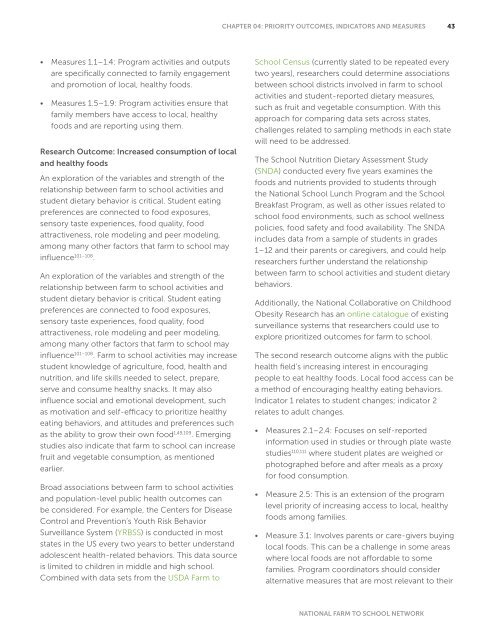Framework-08-25-14_web
Framework-08-25-14_web
Framework-08-25-14_web
Create successful ePaper yourself
Turn your PDF publications into a flip-book with our unique Google optimized e-Paper software.
CHAPTER 04: PRIORITY OUTCOMES, INDICATORS AND MEASURES43• Measures 1.1–1.4: Program activities and outputsare specifically connected to family engagementand promotion of local, healthy foods.• Measures 1.5–1.9: Program activities ensure thatfamily members have access to local, healthyfoods and are reporting using them.Research Outcome: Increased consumption of localand healthy foodsAn exploration of the variables and strength of therelationship between farm to school activities andstudent dietary behavior is critical. Student eatingpreferences are connected to food exposures,sensory taste experiences, food quality, foodattractiveness, role modeling and peer modeling,among many other factors that farm to school mayinfluence 101–1<strong>08</strong> .An exploration of the variables and strength of therelationship between farm to school activities andstudent dietary behavior is critical. Student eatingpreferences are connected to food exposures,sensory taste experiences, food quality, foodattractiveness, role modeling and peer modeling,among many other factors that farm to school mayinfluence 101–1<strong>08</strong> . Farm to school activities may increasestudent knowledge of agriculture, food, health andnutrition, and life skills needed to select, prepare,serve and consume healthy snacks. It may alsoinfluence social and emotional development, suchas motivation and self-efficacy to prioritize healthyeating behaviors, and attitudes and preferences suchas the ability to grow their own food 1,49,109 . Emergingstudies also indicate that farm to school can increasefruit and vegetable consumption, as mentionedearlier.Broad associations between farm to school activitiesand population-level public health outcomes canbe considered. For example, the Centers for DiseaseControl and Prevention’s Youth Risk BehaviorSurveillance System (YRBSS) is conducted in moststates in the US every two years to better understandadolescent health-related behaviors. This data sourceis limited to children in middle and high school.Combined with data sets from the USDA Farm toSchool Census (currently slated to be repeated everytwo years), researchers could determine associationsbetween school districts involved in farm to schoolactivities and student-reported dietary measures,such as fruit and vegetable consumption. With thisapproach for comparing data sets across states,challenges related to sampling methods in each statewill need to be addressed.The School Nutrition Dietary Assessment Study(SNDA) conducted every five years examines thefoods and nutrients provided to students throughthe National School Lunch Program and the SchoolBreakfast Program, as well as other issues related toschool food environments, such as school wellnesspolicies, food safety and food availability. The SNDAincludes data from a sample of students in grades1–12 and their parents or caregivers, and could helpresearchers further understand the relationshipbetween farm to school activities and student dietarybehaviors.Additionally, the National Collaborative on ChildhoodObesity Research has an online catalogue of existingsurveillance systems that researchers could use toexplore prioritized outcomes for farm to school.The second research outcome aligns with the publichealth field’s increasing interest in encouragingpeople to eat healthy foods. Local food access can bea method of encouraging healthy eating behaviors.Indicator 1 relates to student changes; indicator 2relates to adult changes.• Measures 2.1–2.4: Focuses on self-reportedinformation used in studies or through plate wastestudies 110,111 where student plates are weighed orphotographed before and after meals as a proxyfor food consumption.• Measure 2.5: This is an extension of the programlevel priority of increasing access to local, healthyfoods among families.• Measure 3.1: Involves parents or care-givers buyinglocal foods. This can be a challenge in some areaswhere local foods are not affordable to somefamilies. Program coordinators should consideralternative measures that are most relevant to theirNATIONAL FARM TO SCHOOL NETWORK


